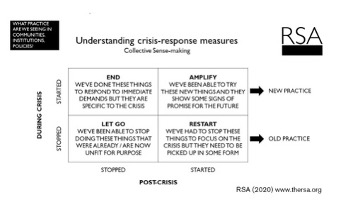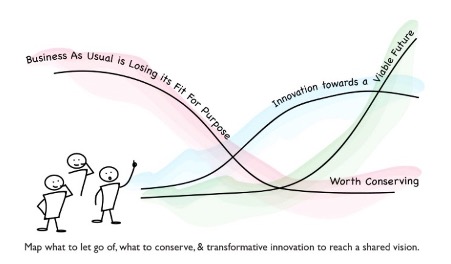Creating order from chaos: encouraging long term thinking about rapid response work
2021-02-11
This month, Jo Hickman Dunne, Project Officer at the Centre, reflects on how we can begin to make clearer decisions about what our services should look like as we move towards the ‘new normal’.
We, like many organisations, have gone round in a bit of a circle over this past year. There’s been the ‘crisis response’ phase – pausing programmes, making decisions about what we could and couldn’t deliver on, and providing rapid and reactive support to friends, colleagues and organisations alike. Then came what we thought was some kind of ‘recovery’, an uneven but perceptible shift towards an old life, where the promise of normality was tantalisingly close. For us, this meant restarting programmes, planning for training delivery, and reaching out to reengage organisations in evaluation practices.
But where are we at now? We certainly never made it to normality, and we’ve been forced back into some kind of crisis response – albeit equipped with a much greater range of knowledge and skills than we had first time around.
This idea of a ‘new normal’ has existed for some time – but we need to start taking it seriously and applying it to our work. From our point of view, we’ve been thinking about what our training offer for organisations might look like moving forward, as we acknowledge that we can no longer frame sessions as something ‘only applicable when face-to-face provision resumes’. We’ve been supporting organisations to think about what adapted delivery means for their theory of change or evaluation processes, and how this moves and flexes in tandem with social distancing restrictions.
For frontline organisations, a focus on the future needs to start with the question: what do we think our post-pandemic provision is going to look like? It clearly won’t look anything like it did in March 2020, but it will also be very different to what it is now. For one thing, the challenges and needs of the young people you are working with have and will continue to change in uncountable ways. For another, through being forced to find new means of connecting and working with young people, you’ll know that there are some things that work really well, and somethings that just don’t cut it.
I want to invite you to think a bit more long-term. To consider, for example, if your organisation is currently conducting home-visits virtually and thinks this is an effective way of meeting young people’s needs – what is it that makes remote home visits high quality? If you are offering provision that aims to support young people’s outcomes, what are the core components that need to be in place that provide the conditions for young people to achieve outcomes? This is course where our role at the Centre becomes important, to reflect on whether we need to re-think the way quality improvement work is delivered in a post-pandemic environment.
Until this point, many of us simply haven’t had the head space to acknowledge that these questions need addressing, let alone answer them. But now, as we hang around in this bizarre limbo between pandemic panic and vaccine utopia, it feels right to start asking:
- What do we want to keep?
- What ideas for remote delivery haven’t we tried?
- What could work better?
- What might work well as dual delivery, part remote and part face-2-face?
- Have we written this down so our team know the fundamentals of remote delivery?
The good people over at Evaluation Support Scotland have been thinking about this too, and they have posted a short blog which poses some key questions around which to frame a plan for your ‘new normal’. They’ve shared this matrix from the Royal Society of Arts (RSA), that recognises the types of activities we’ve engaged in during the pandemic:

If we take what we are currently doing as a starting point – the provision we can offer now, and the mediums through which we can offer it – then we can begin to make clearer decisions about how our services should move forward and what new practices might look like.
Cassie Robinson, Senior Head, UK Portfolio at The National Lottery Community Fund, has also considered this from a funders point of view – how recent funding streams and associated data collection efforts have been focused on emergency response and immediate insights. Whilst these activities are very much about being responsive to the present, the learning from them needs to detect the patterns in this rapidly changing landscape to inform the direction of future work. Cassie draws on the Three Horizons framework as a structure for thinking about long-term change and the future potential of current activities.

As Cassies suggests, this framework can help us to remain aware of the changing landscape of youth provision, and the need to both address todays challenges and emerge stronger on the other side.
We know that, whilst we’ve all had to suppress the urge to throw our laptop out the window at some point over last ten months, technology is not inherently bad – it’s how it is applied that makes the difference. Cassie also makes a contribution to the latest report from the Law Family Commission on Civil Society, reminding us that technology largely didn’t feature in the ways that we delivered on our missions in the youth sector, until now. Of course we would rather build relationships face-to-face than over the screen – but as our youth work has become confined to the digital spaces of Zoom and Facetime, we should focus, systematically and methodically, on how we can enhance the online agency of young people, build a framework of ethical digital practices, and embed systems that move towards equality of access, to formalise how these digital platforms can enable high quality and effective youth work practices in our ‘new normal’.
